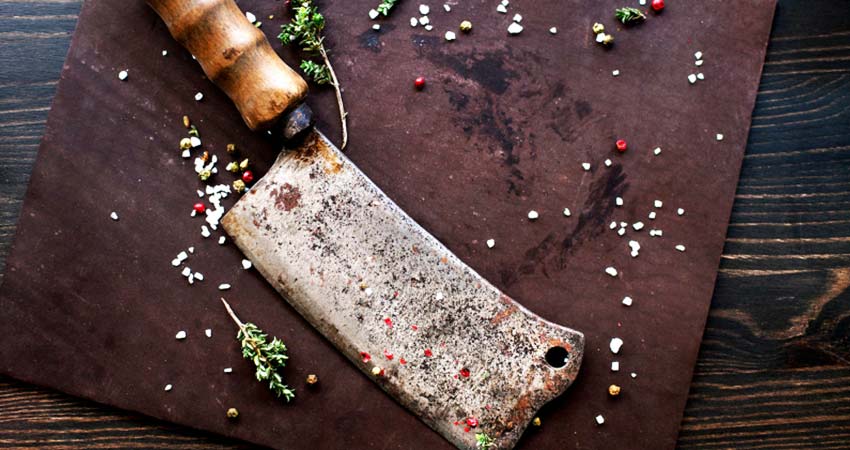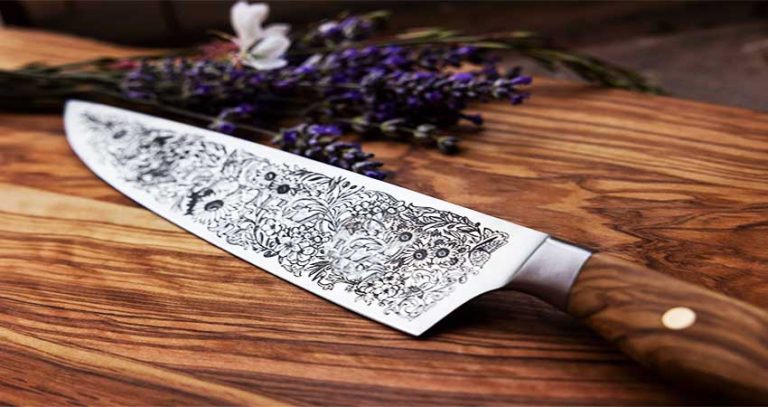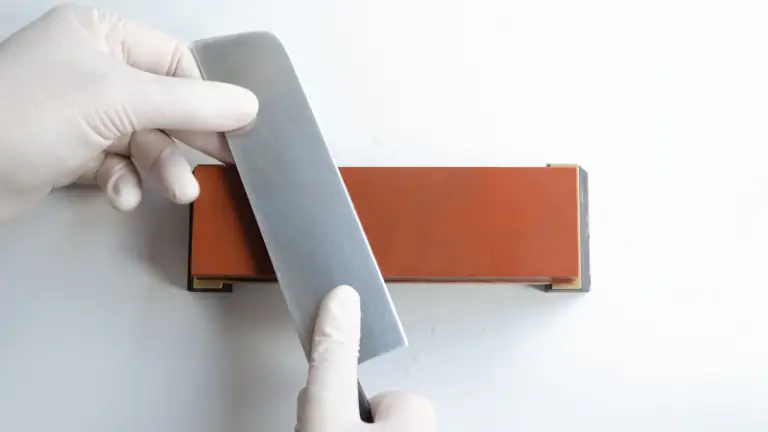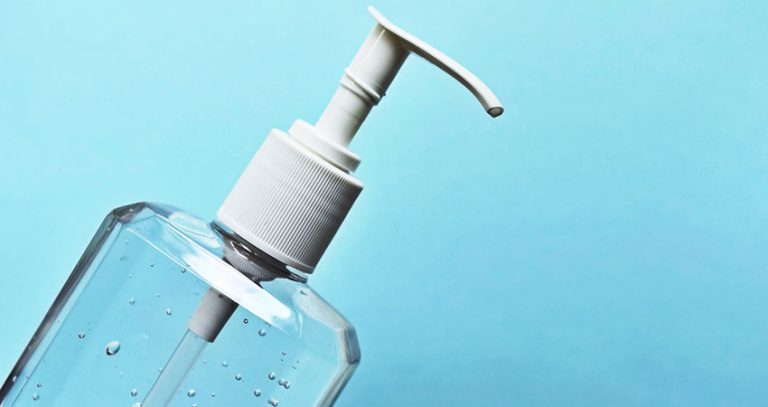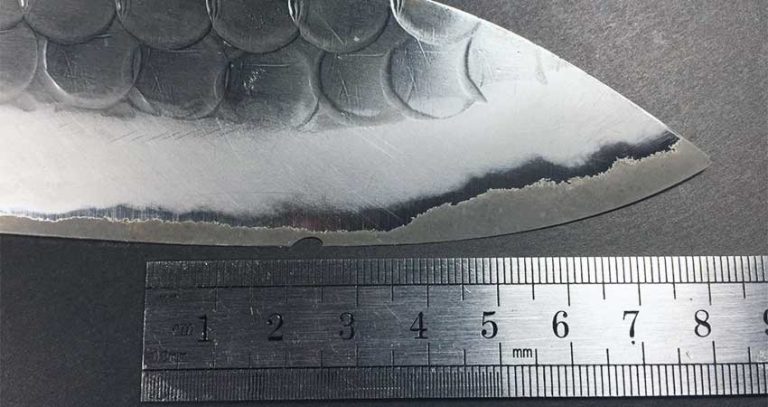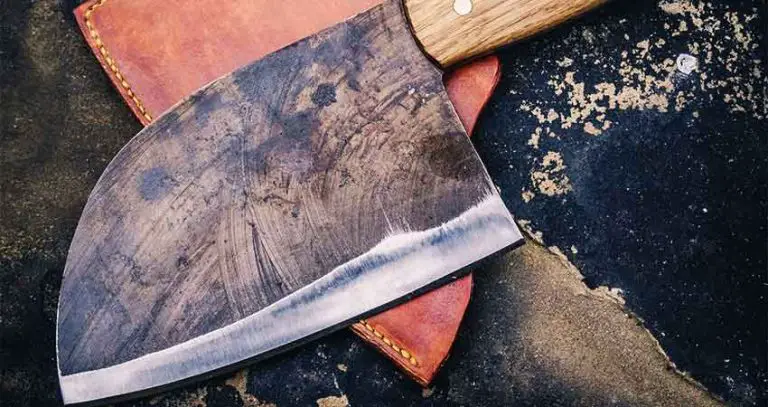How to Remove Rust From Japanese Knife?
Japanese knives are among the finest kitchen knives you can buy. But did you know that their exposed carbon steel core is susceptible to rust?
It’s no wonder “how to remove rust from Japanese knife” has always been a popular topic for discussion.
The good news? If you take good care of your Japanese blade, you will never have to worry about rust. And by good care, we mean always cleaning it after every use and wiping it dry with a cloth.
But what happens if your Japanese knife already has rust spots? Do you just throw it away and get a new one?
In this case, you don’t have to get rid of your expensive knife because you can remove the rust. And in this guide, we will discuss how to go about it.
Different Types Of Rust On Japanese Knife
Overall, there are 4 types of rust that you might come across on your Japanese knife. So, read on to find out more.
Red Rust
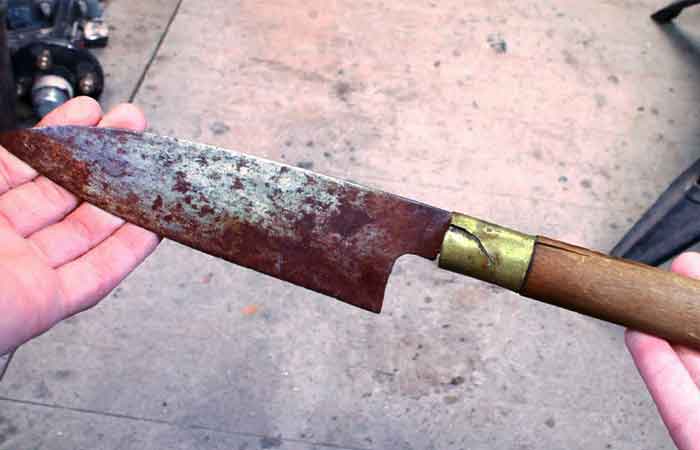
This is the most common type of rust on Japanese knives. Also, known as uniform corrosion, it occurs when you expose your knife to high levels of oxygen and water for a long time.
Unfortunately, if not removed early enough, red rust can be quite severe as it spreads pretty fast.
So, the next time you spot red rust on your knife, you should be quick to get rid of it because it could damage the blade really badly.
Yellow Rust
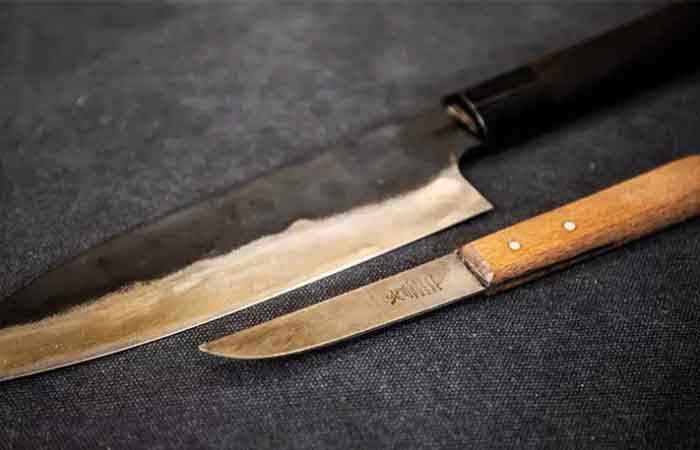
With yellow rust, it forms if your Japanese knife is exposed to extremely moist environments. It might occur when you store your knife in a damp place and stay for a long time without using it.
Unlike red rust, the yellow rust may appear to run or drip from the knife’s blade because it is usually in a solvated state.
The beauty about this rust being in a solvated state is that it is easy to remove. So, compared to red rust, yellow rust is not quite severe.
Black Rust
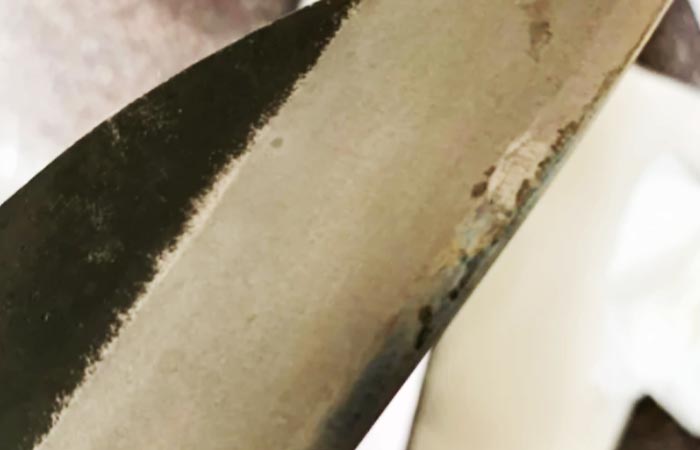
Another common type of rust on Japanese knives is black rust. Basically, it appears when you expose your knife to low oxygen and moisture levels.
Simply put, it may occur when your knife is trapped and covered by something else, thereby preventing oxygen from reaching the knife’s surface.
But what does black rust look like? You can identify this type of rust as a thin black layer that has almost the same appearance as a black stain.
The good thing with this rust is that it does not spread as fast as other forms of rust. As such, its severity is minimal.
Brown Rust
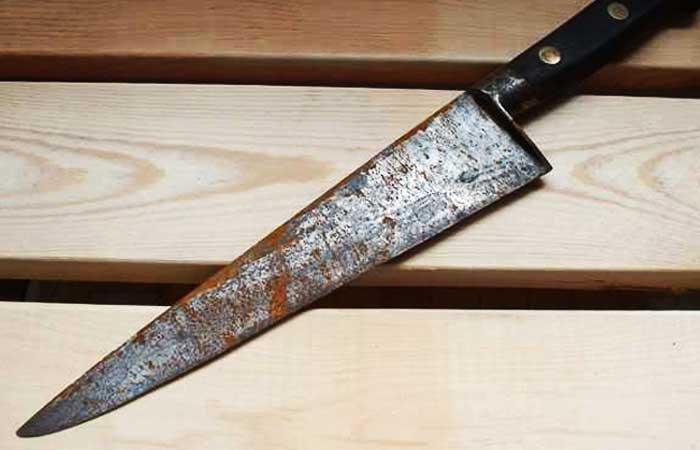
You should also watch out for brown rust which results when your Japanese knife comes into contact with high oxygen and low moisture.
But what really makes it different from the other types of rust is that it is much drier and even crustier.
Apart from that, you will realize that it appears in patches on different spots of the knife.
As such, just like red rust, you ought to take brown rust with a lot of seriousness because it can be hard to remove once you leave it untreated.
Different Methods Involved In Cleaning Rust From Japanese Knife
Depending on how much rust has formed on the blade of your Japanese knife, there are various methods you can use to get rid of the rust.
Let’s check them out.
Sandpaper
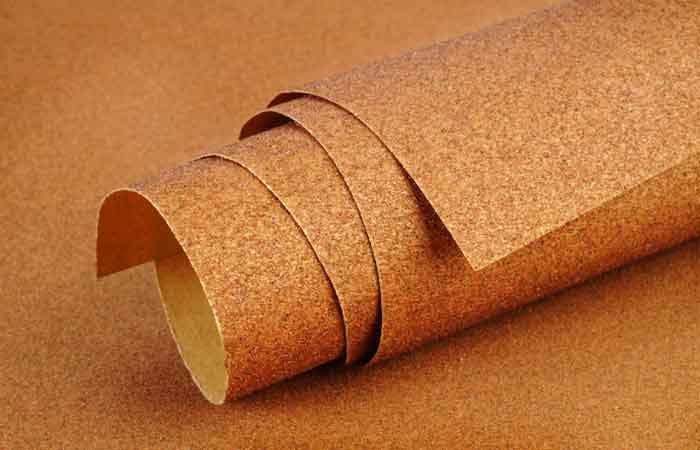
This is probably one of the most popular methods of removing rust from a Japanese knife.
However, to avoid damaging your knife’s blade, we recommend using sandpaper with 1000-2000 grit size.
The method works best if the layer of rust is slightly built-up on the blade.
And here are steps on how to clean the rust.
Step 1:
Start with a piece of sandpaper with 1000 grit and scrub the rusty spot as gently as you can. Just make sure not to scrub one area for too long. You don’t want to damage the blade.
Step 2:
If all the rust patches don’t disappear, you can repeat the process but using sandpaper with high-grit like 2000. Just remember to make quick and light passes as you do the scrubbing.
Steel Wool
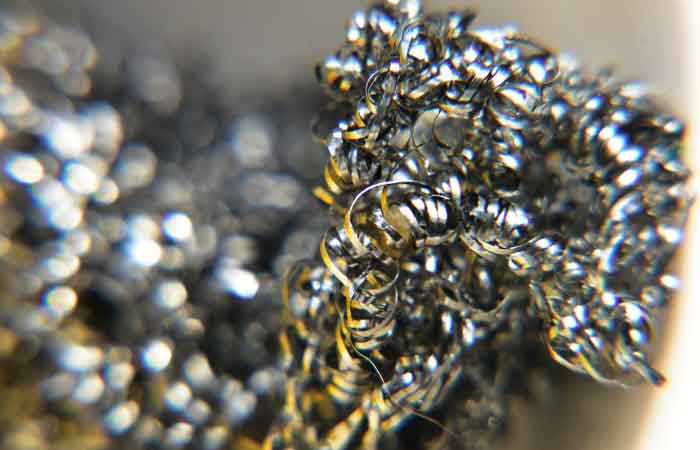
What happens if you don’t have sandpaper with you? In this case, you can just grab a piece of steel wool from the kitchen and start removing the rust.
However, this method is not best suited for removing deep rust spots that have been there on your knife for many months.
And here is how to correctly use this method to clean rust from your favorite knife.
Step 1:
Grab a dry piece of steel wool and your dry knife. Experts are against using wet steel wool on a wet knife. This is because if one of them is wet, the end results may not be good.
Step 2:
Next, start scrubbing the knife. We recommend you place your knife on a stable platform, like on the edge of the table, and start scrubbing the rusted patches of the blade. Doing so will remove the top layer of the rust.
Rust Eraser
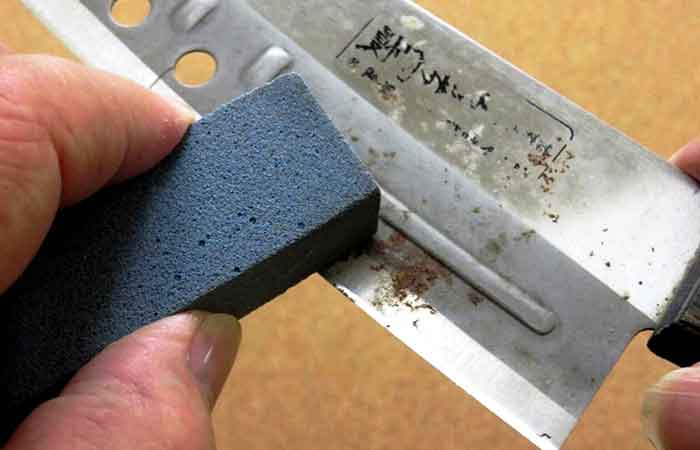
This is probably one of the most effective methods for removing deeper rust spots on carbon steel knives. The erasers are normally available in varying grades, including course, medium, and fine.
So, how do you use a rust eraser on your Japanese knife? You just follow these steps.
Step 1:
Place your knife on a firm surface. It could be on the edge of your kitchen countertop or even on top of a kitchen towel.
Step 2:
Dampen your rust eraser with water and then rub it on your knife’s blade in the same direction. Just be sure to do it gently and repeat the process until you can no longer see any rust.
Sodium Bicarbonate
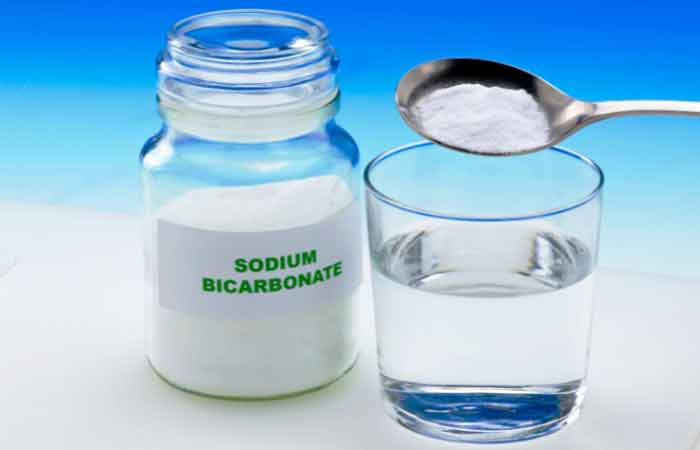
Similar to using steel stool, this choice for rust removal works well on removing light rust stains on your Japanese knife. This is because it is abrasive in nature.
But when it comes into contact with water, it tends to form a concentrated alkaline solution which works well at dissolving rust.
But how does it work? Here are steps on how to clean the rust on your knife using this chemical.
Step 1:
For starters, you should get sodium bicarbonate which is a cheap and readily-available ingredient. Just make sure not to mistake it for baking soda or baking powder.
Step 2:
Find a rag or cloth and dip part of it in water to dampen it. Next, apply a little bit of sodium bicarbonate powder on the damp cloth and rub it on your Japanese blade.
Some Tips On Rust Formation : How To Prevent Rust From Forming In Your Japanese Knife
Some rust can be bad, while others could be good. For the bad rust, it tends to damage your knife by eating into the steel of your blade.
Good rust, on the other hand, is normally the steel trying to protect itself to inhibit rust formation.
With that in mind, we have dedicated this section to teach you some tips on how you can actually prevent rust from forming in the first place on your Japanese knife.
- Always wipe the knife off
After you are done using the knife, always wipe it off using a damp sponge to get rid of any dirt. But don’t leave it like that.
You must use a dry cloth to wipe it dry to remove any water on the surface and then store it in a cool, dry place.
- Avoid washing it in the dishwasher
You should also never wash your Japanese knife in the dishwasher. It’s okay to clean all your dishes in the dishwasher but not your knife.
Always hand wash it after every use using a mild detergent and soft sponge.
- Coat the blade with oil
If you live in an area where the climate is mostly humid or you plan to be away from home for some time, you should add a layer of protective coating on your knife’s blade.
You can use food-grade mineral oil. This will ensure that water does not come into contact with the steel.
- Keep the knife in the blade guard
A blade guard comes in handy in keeping your knife blades safe. But before you put your knife inside the blade guard, always make sure it is clean and dry.
This is because the guard can trap water inside, thereby causing your blades to rust.
Final Thoughts
Every knife in your kitchen is prone to rust and not just the Japanese knife. And even with the best care, sometimes you will just find some rust has formed on the knife.
Even worse, if left untreated, the rust could permanently damage your expensive Japanese knife.
So, knowing how to remove rust from Japanese knife and keeping it from developing the rust is critical if you want the blade to last for many years.
Just be sure to follow the right procedure for removing the rust.

